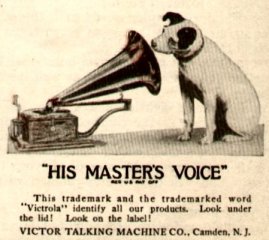Victor Talking Machine Company
Soon after inventing the disc gramophone Emile Berliner went looking for someone to design a “clockspring” motor for it so that the records would not have to be turned by hand. He turned to Eldridge Johnson, who owned a small machine shop in Camden, New Jersey, right across the river from Philadelphia, where Berliner worked. Johnson designed the new motor, but became so interested in the gramophone that he continued his efforts to improve it. Soon Berliner and Johnson formed a partnership.
The early gramophone industry was beset by legal battles over patents. By 1901 Johnson and Berliner agreed to pool their resources and form a new corporation. They named their company the Victor Talking Machine Company. Victor would manufacture both records and phonographs to play them on. Johnson became the president, while Berliner turned to other projects. In the following years, Victor became one of the largest companies in the music industry, and so did the English Gramophone Company, formed in 1897 (which later became Electrical Musical Industries or EMI). Between the American and English companies, Victor owned record plants and wholesalers in Germany, South America, Japan, France, India, Italy, Russia, and the Netherlands. The international scale of the company helped introduce music from all over the world to the United States. Conversely it introduced American forms of music such as Jazz to people in far-away places. The famous Victor trademark, the dog Nipper listening to the gramophone and the words “His Master's Voice,” was adopted around 1901. It became one of the most famous trademarks in the world.
Sales of Victor records and record players took off. Johnson hired an American, Fred Gaisberg, to travel to Europe to collect songs from artists there. Gaisberg made a major score. Well known opera singer Enrico Caruso recorded a set of records for Victor that was released in Europe and the United States. The success of the Caruso records helped catapult the Victor Company to new heights. Victor also introduced an extremely successful record player called the Victrola. Soon the word Victrola became the generic term for a record player.
Victor’s success was short-lived. Although early radio broadcasts of music did not sound as good as the phonograph, the new technology succeeded anyway. The impact of radio on the phonograph was so big that by the late 1920s, many people thought the record industry was going to disappear entirely. Johnson sold his share of the company for about $22 million in 1927, as did the other stockholders. This once-great company changed hands once more and was purchased by RCA (the rival radio manufacturer) in 1929. RCA was itself in trouble the next year when the Great Depression began—Johnson sold out just in time.
The Victor name lived on as RCA-Victor. The company continued making record players and discs in addition to radios. In later years they made tape recorders and other audio equipment. Over the course of two world wars and major changes in the electronics industries, the companies that were once united under the Victor label have split up. But some of them survive. The names RCA and Victor survive in the U.S.; the Japanese Victor Company is today known as JVC, the Berliner record factory in Hanover, Germany is known as Deutsche Gramophon; and EMI is a descendant of the English Gramophone Company, as is the record retailer HMV (His Master’s Voice).
